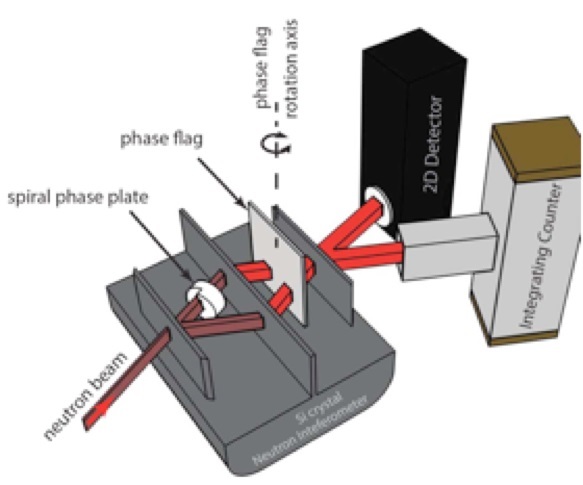September 24, 2015
An experiment by a team of researchers led from the University of Waterloo’s Institute for Quantum Computing (IQC) shows, for the first time, that a wave property of neutrons, Orbital Angular Momentum (OAM), can be controlled.
This newfound control of neutron OAM states means that researchers can now use neutron OAM beams to see inside materials that optical, x-ray or electron OAM beams can’t penetrate.
This control can help measure the magnetism, for example, in magnetic materials, as well as deeper probes of superconducting and chiral materials.
Neutrons are the probe of choice for many materials. Researchers use neutrons to learn more about material properties, such as crystalline structure or magnetic signature. Neutrons are massive, penetrating and neutral particles, and they also exhibit wavelike properties.
OAM is associated with the rotation of an object around a fixed axis. For example, the OAM of a planet around the sun is related to the distance of the planet to the sun and its speed. Control of OAM has already been shown using different methods for beams of optical light, x-rays and electrons.
It was at a talk about electron OAM where Research Assistant Professor Dmitry Pushin, a member of Waterloo’s Department of Physics and Astronomy, and collaborator Charles Clark of the Joint Quantum Institute in Maryland conceived of the idea to control neutron OAM. Pushin then designed the experiment to prove it.
Pushin’s experiment uses neutrons created by a nuclear reactor at the National Institute of Standards and Technology (NIST) and passes them through a Mach-Zehnder interferometer.
Although there is never more than one neutron in the interferometer at any given time, the neutron can be thought of as a pulse of waves. The neutron waves meet a blade of silicon and break into sub-beams. One of those beams then hits a spiral phase plate which impresses a twist on the neutron beam, giving a different OAM to the waves taking that path than the waves taking the other path. The twist quantizes, or entangles, the path.
The sub-beams then strike a second silicon blade that directs the two beams to the same spot on the third blade Before the two sub-beams merge and interfere with each other at the third blade, a phase flag fine-tunes the phase of the neutron sub-beams. Finally the interference pattern is recorded at the third blade in a two-dimensional detector to confirm that the extra OAM has been controllably imparted.
“Before, we could only study the spin, path and energy degrees of freedom of chiral materials,” said Pushin, also a Program Researcher for the NSERC CREATE Program for Neutron Science and Engineering of Functional Materials. “In principle, we showed that we can change the OAM by any specified value. We can now study these materials with spiral structures such as DNA without being limited by the degrees of freedom for neutron-based studies.”
“The new control over OAM states enables neutrons to now probe the helicity of materials including liquid crystals, helical magnetic ordering and topological materials,” said David Cory, Canada Excellence Research Chair and faculty member with IQC and the Department of Chemistry. “A particularly exciting opportunity is to combine our quantum control of neutrons with the study and engineering of quantum materials.”
The paper, Controlling Orbital Angular Momentum, a collaboration by Pushin, Cory and colleagues from Joint Quantum Institute, NIST and Boston University, was published in Nature on September 24.















